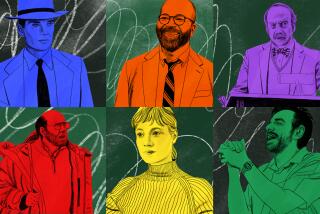‘Institute Benjamenta’ Wields an Eerie, Passionate Power
- Share via
The world of animation is one in which the artist’s control of his or her medium is absolute, and few animators have used their power so imaginatively as Timothy and Stephen Quay. It is entirely fitting that their dazzling, eerie first live-action film, “Institute Benjamenta,” not only approximates closely the control they had in their earlier medium but also becomes a meditation on the power of the artist over his creation.
The Institute Benjamenta is a training school for servants, in either Germany or German-speaking Switzerland--the film, however, is in English--somewhere around the turn of the century. When Mark Rylance’s Jakob von Gunten enters the institute’s maze-like building, he has no way of knowing he’s to be the last pupil. He has, however, plunged into a world so bizarre he at one point asks himself if he hasn’t somehow ended up in a fairy tale. To sign up at the institute isn’t merely giving one’s consent to become a slave but, beyond that, to become a virtual marionette, even eating meals in unison with the other pupils, all of them unprepossessing young males with exceedingly low expectations of life.
What gradually becomes apparent is that Lisa Benjamenta (Alice Krige) and her brother, Herr Benjamenta (Gottfried John), who run the institute that bears their family name, are growing tired of their existence, in which routine has hardened into absurd, deadening ritual. Reducing their pupils to automatons does nothing to assuage their terrible loneliness. As deep-dyed puritans, they’ve repressed their sexuality until they’ve become addicted to the madness that it has induced in them. Herr B. lusts after his sister, who lusts after Jakob, who with his mix of innocence and intelligence also attracts Herr B. You feel, however, that the slaking of the passions that are ravaging the Benjamentas is the last thing they could deal with. All three actors come through with a blend of discipline and passion that the Quays and their co-writer, Alan Passes, require of their parable.
Jakob’s remark about seeming to be in a fairy tale is apt as far as appearances are concerned. Filmed superbly by Nic Knowland and accompanied by Lech Jankowski’s jarring minimalist score, “Institute Benjamenta” has the delicate, gauzy, high-contrast black-and-white look of Cocteau’s “Beauty and the Beast,” but has the feel of a machine--one that’s running out of control.
Indeed, the film can be taken as a cautionary tale about the dangers of regarding the universe as a mechanism instead of as an organism. Yet this mechanistic view is one that has characterized the work of many an animator, most notably those in Eastern Europe--and the Quays themselves. “Institute Benjamenta,” which has the feel of a work of self-liberation, leaves you suspecting that the Brothers Quay are aching to set their creations free to find a life of their own.
* Unrated. Times guidelines: The film is too intense and complex for children.
(BEGIN TEXT OF INFOBOX / INFOGRAPHIC)
‘Institute Benjamenta, or This Dream People Call Human Life’
Mark Rylance: Jakob von Gunten
Alice Krige: Lisa Benjamenta
Gottfried John: Herr Benjamenta
Daniel Smith: Kraus
A Zeitgeist Films release of a Film Four presentation, with the participation of British Screen, of a Koninck Studios production, in co-production with Image Forum and Pandora Film. Directors the Brothers Quay. Producers Keith Griffiths and Janine Marmot. Screenplay by Alan Passes and the Brothers Quay, drawn from the novella “Jakob von Gunten” and other texts of Robert Walser. Cinematographer Nic Knowland. Editing and sound montage Larry Sider. Costumes Nicky Gillibrand. Music Lech Jankowski. Production designer Jennifer Kernke. Running time: 1 hour, 45 minutes.
* Exclusively through Saturday at the Nuart, 11272 Santa Monica Blvd., West Los Angeles, (310) 478-6379.
More to Read
Only good movies
Get the Indie Focus newsletter, Mark Olsen's weekly guide to the world of cinema.
You may occasionally receive promotional content from the Los Angeles Times.










